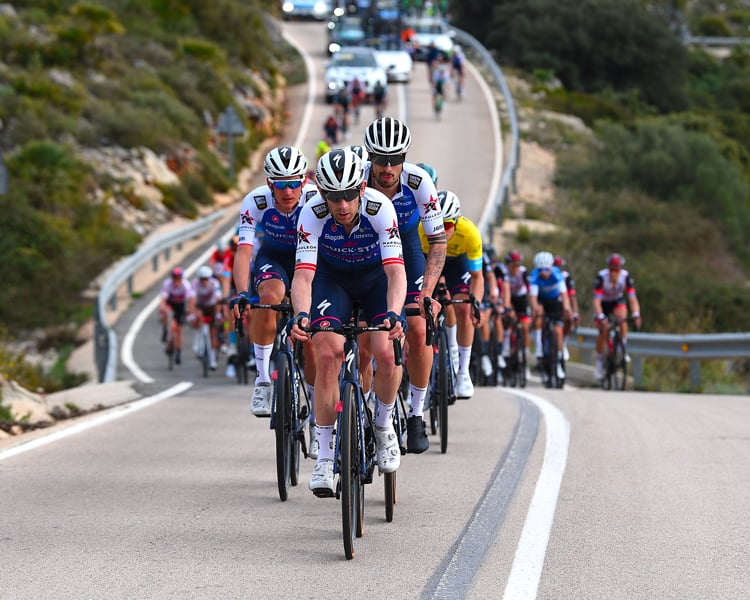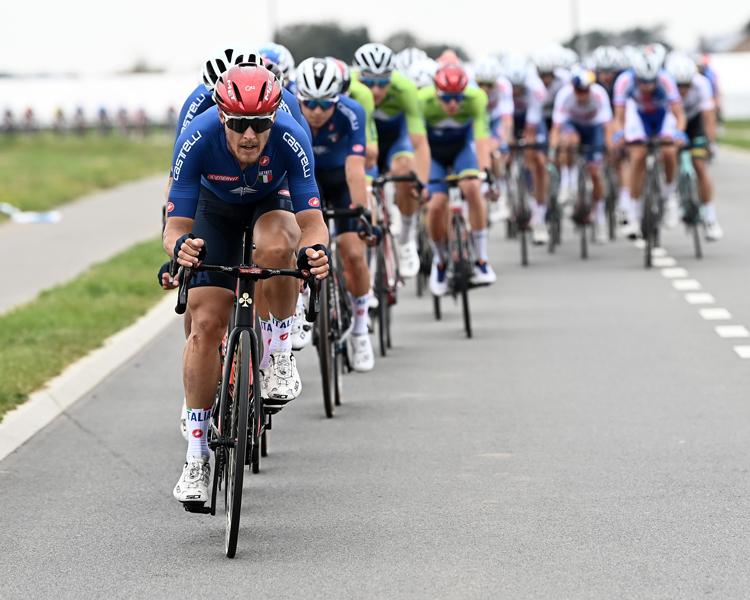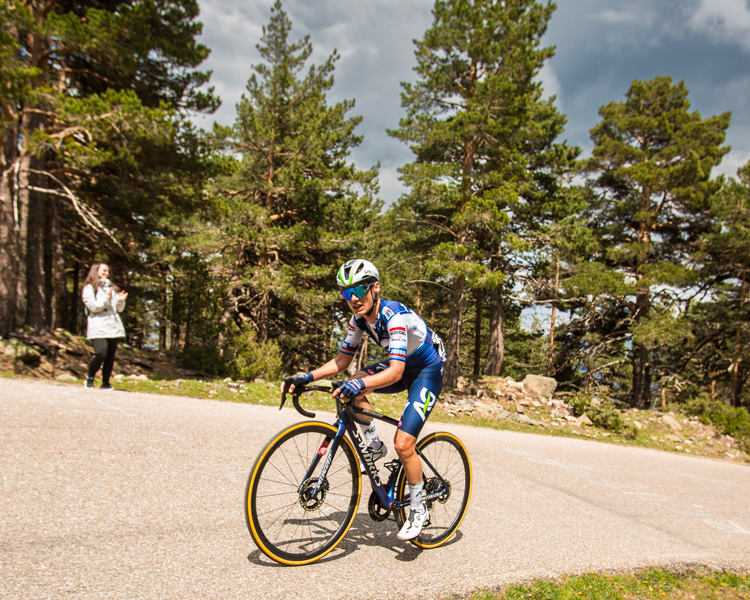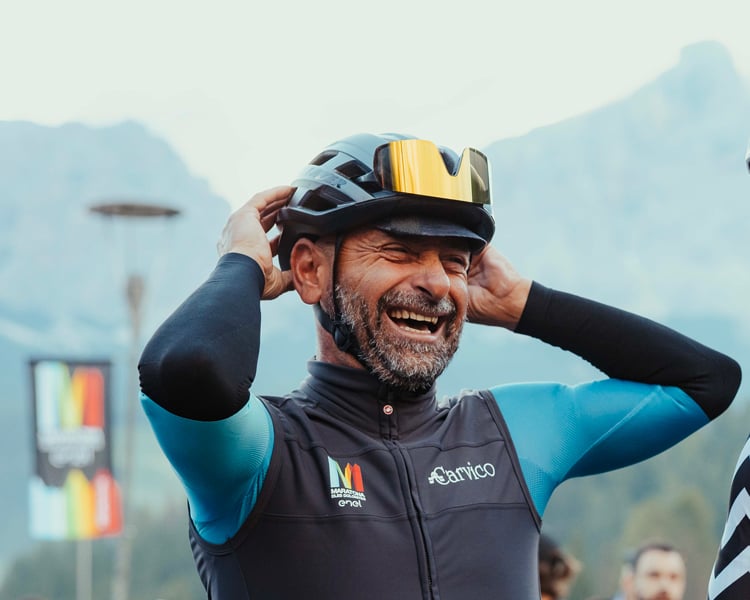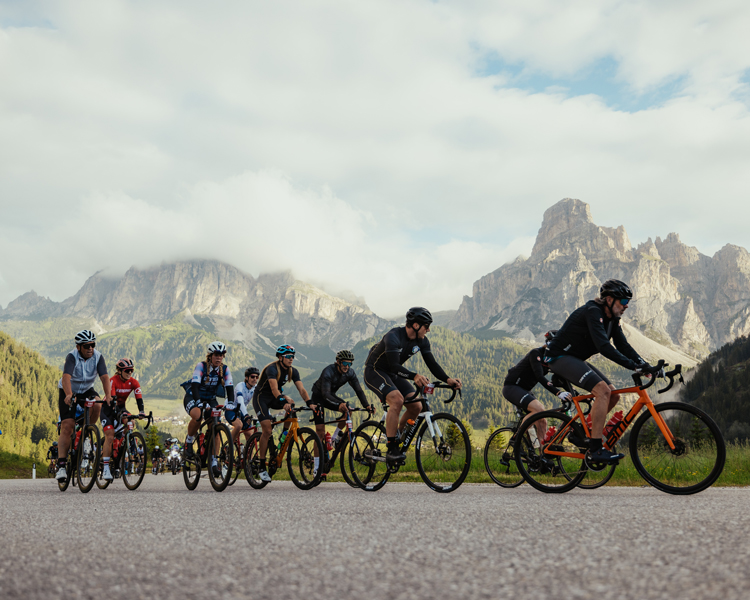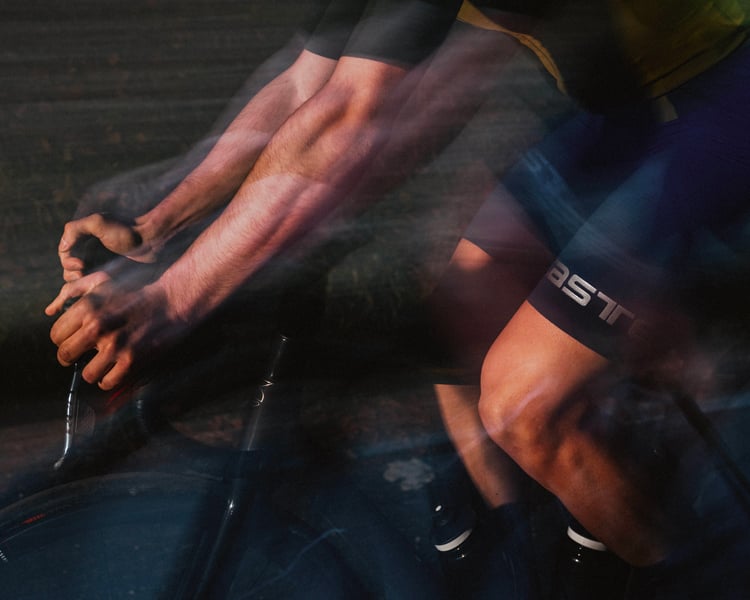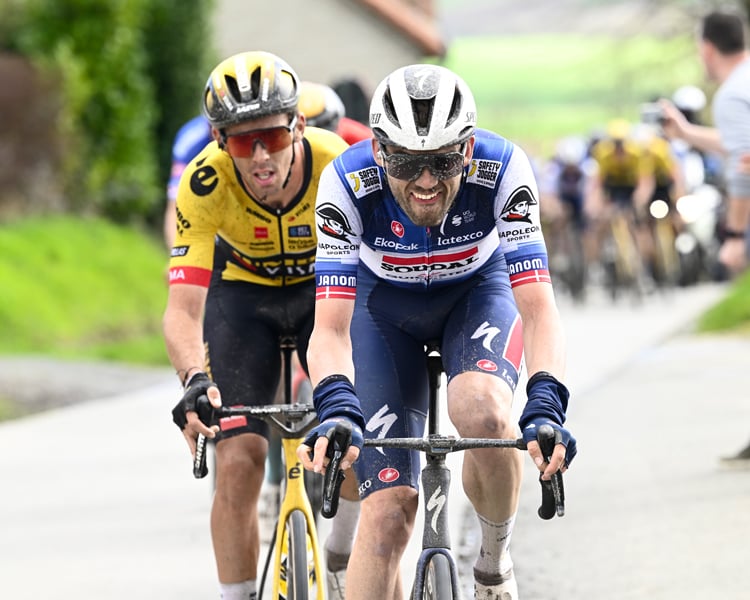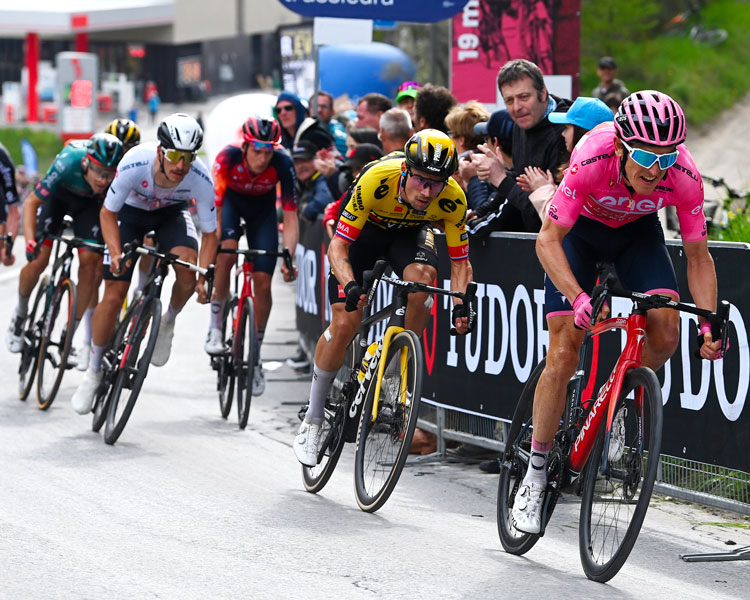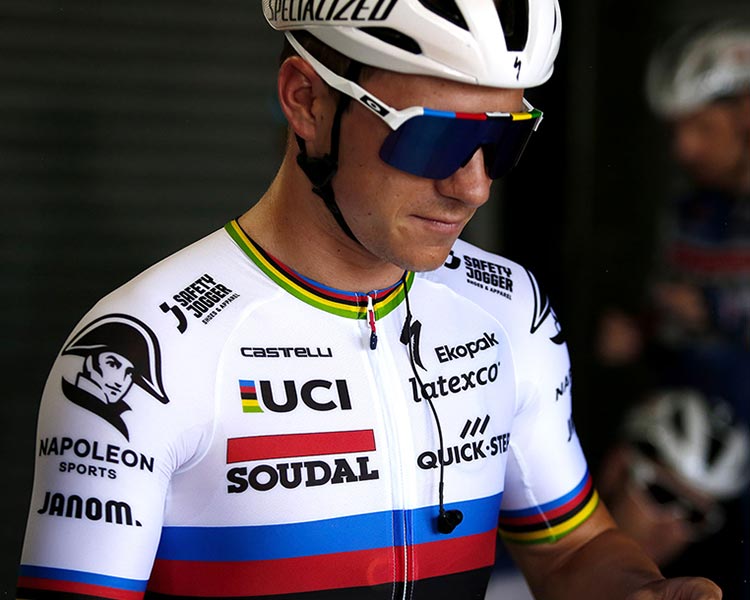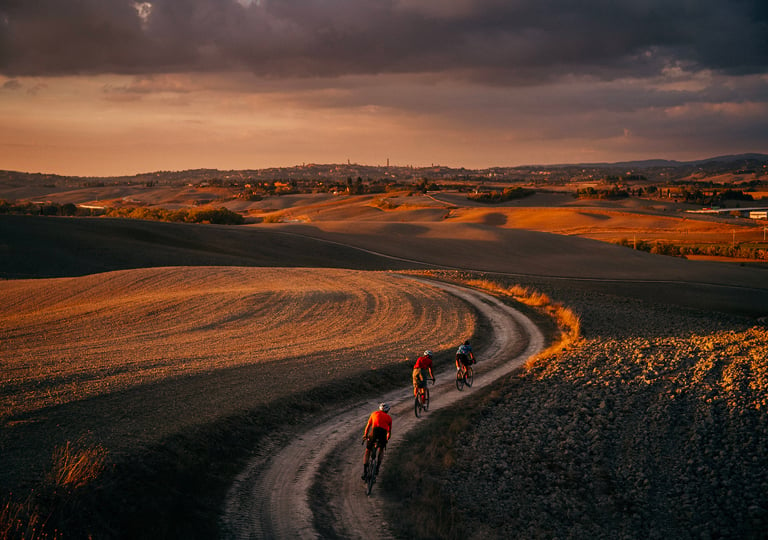
Steve will take us through his unforgettable two-day journey, riding through Tuscany's stunning scenery and charming towns. Talk about how to prepare for this gravel adventure, what clothing to wear, logistics, and more.
The Tuscany Trail is the first bikepacking event, and one of the biggest in Europe. It stretches almost 500 km, with 7,000m of elevation gain, riding from the North to the South, in and out of central Italy’s coast. The route is uploaded on the GPS, and to be covered at one’s own pace, without time limit, self-sufficient because adventure is a right that must be within everyone's reach, as true adventurers of the twenty-first century.
Hope you’ll enjoy the episode!
TUSCANY TRAIL
Website
TOPICS COVERED & TRANSCRIPT
(00:00) Welcome
(01:32) Tuscany Trail preview
(03:59) Dates, logistics, equipment
(10:21) Fueling
(12:06) Logistics, sleep
(15:29) What sets Tuscany Trail apart from other events
(17:46) Training preparation
(22:06) Soaking in the sceneries
(22:40) Group size
(23:03) People from all over the world
(24:09) Bike setup
(25:35) How to dress
(29:06) Celebration of cycling
(32:09) Ending
SOREN JENSEN
What makes a great cycling event successful, and why are we more interested in riding further and self-supported than ever before.
Hello everyone, and welcome back to the Castelli Podcast! This is the show where we delve into the world of Castelli and uncover the stories from the people behind the brand. We'll explore what inspires us to create the most performance-driven and comfortable cycling clothing, all aimed at helping cyclists around the world go further in greater comfort.
I'm your host, Søren Jensen, Castelli marketing manager, and today we have a fantastic episode lined up for you with a very special guest. On today's episode of the Castelli podcast, we’ll have a chat with Castelli’s Brand Manager, Steve Smith, who rode the 2023 edition of the Tuscany Trail.
Steve will take us through his unforgettable two-day journey, riding through Tuscany's stunning scenery and charming towns. Talk about how to prepare for this gravel adventure, what clothing to wear, logistics, and more. Steve shared his story with the rest of the Castelli marketing team over a cappuccino yesterday, So, I couldn't resist the opportunity to have him share his story with all of you today.
Now, for those of you who may not be familiar with the Tuscany Trail, don't worry; we'll begin with a quick overview of this remarkable event. So, sit back, relax, and get ready to be transported to Tuscany!
The Tuscany Trail is the first bikepacking event in the world and the first and original “unsupported bicycle adventure”. It stretches almost 500 km, with 7,000m of elevation gain, riding from the North to the South, in and out of central Italy’s coast. The route is uploaded on the GPS, and to be covered at one’s own pace, without time limit, self-sufficient because adventure is a right that must be within everyone's reach, as true adventurers of the twenty-first century.
From a modest start ten years ago, the event has now grown to have 3,000 starters, and has grown to be one of the biggest bikepacking events in Europe. Cruising along a rolling section of roads and trails, you’ll find people of all age groups, from more than 35 different nations come together, dressed in everything from aero fitting lycra to casual clothing, with a wide span from tiny to big bikepacking bags, steel, carbon and titanium gravel, and mountain bikes.
The route takes in several UNESCO world heritage sights, Roman buildings from before Christ and towns that feel like you’ve jumped at least a 1000 years back in time. These amazing centers of culture are surrounded by twisting vineyards, endless olive groves, lines of cypress trees, country houses, and medieval villages.
Of course, there’s some of the classic rolling hills and white roads known from ‘Strade Bianche’ and L’Eroica, that the area is so famous for, and there’s also a broad range of trail surfaces, including farm trails, forest roads, cobbles, and paved sections.
This is all mixed with amazing local cuisine, public water fountains to stay hydrated, and the steady pace of life makes for an ideal bikepacking destination.
Truly, this is a Tour de Force of the Tuscany region, with so many highlights and fantastic trails, you literally don’t know whether to stop at every one and spend two weeks riding the route or just soak it all in all you pass, saving those special moments to come back one day and tour it slowly, savoring the route as if it was a tasting tour of all the local specialties of La Bella Toscana.
Welcome back to the show, Steve. Let's dive right into where we left off this morning when you shared your riding experience on Tuscany Trails. To begin, could you provide us with some details about the event and course and dates?
STEVE SMITH
So, Tuscany Trail is Europe's biggest bike packing event. So it's a 480 kilometer route through Tuscany which if you've been to Tuscany you know there's not a practically not a single flat meter of roads in Tuscany but it is one of the most beautiful spots on earth. So 480 K there's a start and there's a finish and there's a route and what you do in between is up to you. So most people did the intelligent route and tried to do it in four days. Numbered it in three days, which would be what, about 160K a day. I rode it with Davide Cassani and Alessandra Fior and we did it, tried to do it in two days. So that was our goal as we set out and pretty much did that. Then there was a few people that did it one shot, which those guys are nuts. So I don't know if anyone finished in under 24 hours, but that would be quite an undertaking. Wow. And then there were just a few of us. We didn't see a lot of people doing it in two days. A lot of people in three. I think that probably the most popular of those four days, which is still 120 K of gravel a day. So it would be six, seven hours on the bike.
SOREN JENSEN
That's a long day on the bike. Yeah. And how was the temperature?
STEVE SMITH
We had everything from a proper hot to like 12 degrees and pouring down rain. So it was wide, wide range.
SOREN JENSEN
How did you cope with the weather change both with the rain and hot weather?
STEVE SMITH
I mean obviously we have the right clothing for that. So the day before looking at the forecast, I put in an insulation layer, put in an Idro jacket of course, vest and then generally just went with it. I did one day with a premium short, one day with Superleggera bibshort. And yes, I dressed fairly lightly because on each day we had some hot weather and then in the afternoon we had thunderstorms and then it got nice again towards the evening. They got cold or cool towards evening. You know layering was definitely it and so on the bike I had a big seat bag with a change of clothes because you know I don't want to do too straight 13-hour days in one pair of shorts so had a full complete change of clothes and then they had those layers for whatever conditions either between a pocket and the seat or the the frame break that way they're really easy accessible because every time you open up that seat bag it loses some of the compression and if it's not compressed well it sits there and just rocks back and forth and drives you nuts. I tried to just put in stuff that I needed like the next day or emergency stuff like a spare tube. I had one spare tube in the frame bag and then the other one in the seat bag and all the chargers that I needed that night.
SOREN JENSEN
Did you encounter any mechanical difficulties throughout the course?
STEVE SMITH
The only kind of semi-mechanical I encountered was… it rained so much the first day, the chain went totally dry and I didn't bring chain lube. And just like at the point when it was kind of starting to bother me, there was a, I think the only one I saw in two days, there was a Shimano neutral support. So pulled in there, a fresh bath of oil on the chain and we went.
SOREN JENSEN
And it was the wind. Yeah. Nice. Must've been tough riding that distance over two days in all kinds of weather.
STEVE SMITH
With the benefit of hindsight, two days was kind of my limit of what I wanted to do. So we were on the bike for 12 and a half hours the first day and 13 hours the second day. That's actual riding time. And then you have the biggest thing in these long events like this is just keeping your body fueled. So you're stopping to eat, you're stopping for lunch. I mean, there's a good number of stops on the way. So it turned into leaving about 630 each morning and then got to the hotel at 10.30 at night on the first day and finished at about 1.30 in the morning on the second day.
STEVE SMITH
Yeah, but 7,000 meters of climbing, 60% off road. Most of that was good gravel. Some of it was on Strade Bianche, which is better than roads. Some of it was on gravel, dirt roads that were kind of rough. And then probably out of the entire two days, there were probably two, two and a half hours that were on really rough stuff that you'd be happier on a dual suspension mountain bike.
SOREN JENSEN
So you guys basically hit the trails also. Nice. How do you feel about riding in a trio with Davide Cassani and Alessandra Fior?
STEVE SMITH
Yeah, it was awesome. It was a company, it was really good. Davide, he did it the hard way. He got his first gravel bike the day before the event. It was all new to him. So yeah, he had to learn as he went. But you know, nine tours of France means that the guy knows how to ride a bike. So it was fine. And then Alessandra, she's done a lot of these ultra things and she was, she's probably the strongest one of the bunch. Yeah, she's a great rider. And so it was good. We were fairly evenly matched. Those guys are faster in the hills than I was and then on the flats, I don't know why I've got a climber's physique, but a ruler body motor. But 7,000 meters, there's a lot of climbing there.
SOREN JENSEN
That's a lot of climbing. Also I mean we know that from terrain or the area of Tuscany with those rolling hills, but we all know from the Strade Bianche and l’Eroica.
STEVE SMITH
Yeah. But just to put it in perspective, the start of the second day from Buonconvento is part of the route from the Strade Bianche. The first 55K we did about 1,600 meters, which is the same as the Maratona Sellaronda. True. But there was some flattish sections in there, so the hills were actually steeper. So it was a good challenge.
SOREN JENSEN
Yeah. So did you also ride in groups with some other people when you guys left, or?
STEVE SMITH
Yeah, so the way the stages start is you can start from, I think it starts about six in the morning on that, the first of June, and then people, I think that you're supposed to start within the second day. So people started kind of rolling out all together. And that first day we were almost always with other people. So, I mean, you kind of jump between groups because somebody's fast or somebody's slow or somebody, you stop to eat. So you're not really with the same group the whole time, but you're always with people. We took an approach of more stops to eat, and take all our fuel with us. And so it was kind of funny, we passed the same guys like 10 times. So guys that were slow and steady versus us, which were fast and stoppy.
SOREN JENSEN
Where did you stop to eat? Like, did you just have a normal panino or did you actually stop for some real food or did you do that in the evening?
STEVE SMITH
Yeah, no, so we had breakfast before we started then at 6.30/6.45 and then about 9.30. There was a great little bar Breakfast spot. So we had a second breakfast after three hours and then we rode. We had a proper sit-down lunch at a restaurant. You know, we took our break there at Volterra, yes, it was. Yeah. So beautiful. We were pretty much ready by then because there's a long climb up to Volterra which is pretty challenging. Yeah. And then yeah, they keep going like that. So you know every two, three, four hours you got to put in some proper food. Then you're eating bars or packed sandwiches. I put it basically in my frame bag and it was mostly food. It probably had 10,000 calories in it. So you just got to get, that's the biggest thing about these. And that's the message I would give is like, guys, these long events are kind of fun because it's a big adventure and they're actually easier than it sounds like. Because if you think about going off and doing a 12-hour ride or 200 and 40K of gravel, it sounds really daunting. But the biggest thing there is just you gotta go easy because your legs, there's nothing you can, your legs can't go hard for that long. And so what it really becomes is a matter of eating. I mean, you gotta train a bit for the long distance, but then after that, yeah, you just keep the fuel coming in. You gotta, you start the day with your tank full, and then you have to kind of feather it down and kind of find that equilibrium where your output is the same as your input. And then you kind of settle into your pace and you could just go forever.
SOREN JENSEN
Who was in charge of the logistics? Was that you?
STEVE SMITH
I was actually going to do the event with another friend of mine with whom I'd done the Veneto gravel. So we've done the Traca together. We've done Jeroboam together. We did Veneto gravel together. So pretty evenly matched. And then something came up for him. But in the meantime, I had reserved at Buonconvento, exactly halfway. So, an event like this was challenging because there's so many people out there on the road, you can't just count on finding a spot when you're tired. You have to plan ahead and pick that or you're going to stop, which means you have to get there. And so, yeah, it puts a new challenge to it. Now, we looked at the route and said, okay, I think we can do 240K that first day. We did and we stayed out pretty good and got there at 10: 30 at night. Would have been nice to have gotten there a little bit earlier too. But because of the way our timing was we stopped and ate right before we got to the hotel. You know I could have pushed on but then you get to the hotel at 9 o'clock and then it's kind of late to eat. Yeah. You're kind of there in the evening when you plan your ear stops.
SOREN JENSEN
You arrive there at 9 o'clock and then you get your shower, clean up your stuff and then you have dinner, but you don't really sleep that much because in less than six hours time, you need to be back out there on the bike. Now you said you're leaving at 6.30 in the morning.
STEVE SMITH
No, so we, we, I'll tell it 10.30, just like unpacked, took a shower and then immediately went to bed, slept seven, seven and a half hours, and then woke up, ate again, headed out 6.30, 6.45. So, you know, there's some of these guys that'll sleep two, three, four hours a night, which I don't understand. There's some guys that'll take, you know, sleep in their tent or a bivy bag and I don't know, I just, that hot shower and a proper bed to me makes a world of difference. For me, for this stuff, I want to keep a smile on my face. That's my main goal. So if it takes me a little while longer, that's okay.
SOREN JENSEN
But you also got a lot of stuff there at night, maybe to charge from your phone, from your Wahoo device or Garmin to lights?
STEVE SMITH
Yeah, no, so for sure you've got all the electronics to charge. Here I invested into really good lights. And so the big light, on my handlebars, has an external battery that doubles up as a power bank. So some of that stuff will charge on the way and then get to the hotel. It's mostly phone and the bike computer, you have the route on there. Yeah. And then backlight, of course, you always want to have always.
SOREN JENSEN
Yeah. But it must have been amazing crossing all the hills because it's not your first time for you in Tuscany. I mean, after your 23 years, 24 years almost living in Italy. Yeah. You've been to Tuscany a lot of times. I know when you've done the Strade Bianche, Sportive. Every year. Every year. Yeah. So you have a big love for Tuscany and Italy in general?
STEVE SMITH
So I've been down there a lot. But even so, out of the 480K, I think something close to 400 kilometers of this was all new to me. Wow. So a lot of places, towns I've been to, maybe not that road, but also discovered a lot of cool places. Definitely going to go back and do a little bit more friendly route and go back with the wife and do it in longer than two days.
SOREN JENSEN
So that leads to another question here, what sets it apart from other cycling adventures or bikepacking events that you have done?
STEVE SMITH
I think anyone who's been to Tuscany knows how spectacular it is. So the scenery, just everything about Tuscany is amazing, but here you don't really have big super long climbs, but not a lot of flat either. So you don't get onto a climb that takes you an hour and a half. And then here, generally, the roads were okay. A little bit rough in places, but fairly smooth. And then of course, Tuscany, you've got the advantage of great food the whole time. Even though we did stop at a pretty low level pizza, fast food place, but that was what we needed at that point on the afternoon of the second day.
SOREN JENSEN
I mean, also writing, I mean, you were writing with two good friends and just soaking up the beautiful landscapes and being in amazing company. I remember also watching some of your stories that you posted on Instagram, on Strava. I mean, you could see it just like, it was something that was enjoyable. It was something that was not a race, even though you guys rode 240 kilometers and 3,000 plus meters of climbing per day. But do you think this is a bucket list ride?
STEVE SMITH
Definitely, I'd put it up there. Just because it's, yeah, the spirit of the ride too, because nobody's out there racing. And so it's just like every hour that is constantly changing, they take you to some absolutely spectacular places. Yeah, so it's really a big adventure, especially I think if you broke it down into like three, even better would be four days. Like go ahead and push for those 120K you're riding, make it to a hotel by mid-afternoon with a pool. That would be an amazing four-day holiday. Two days is at the limit.
SOREN JENSEN
It may be a little bit of a limit. Maybe three days are better. Maybe I might even join you next year then. I'll be up for that one.
STEVE SMITH
Okay. Three days is still almost 10 hours, nine hours a day of riding. So it's still a solid day. Solid day, yeah. But yeah, it's a little bit more manageable than two days.
SOREN JENSEN
I need to get some longer rides in. I think the last long one I did was probably 14, maybe more 15 years ago when we rode back from the Eurobike show, you remember?
STEVE SMITH
Yes, preparation for this is actually a little bit easier than other events because you just have to get in some long long days. So yeah, I've done a number of these long, we call them ultra. I mean ultra to me is more like transcontinental or and then go to court or race across America. Yeah, more extreme. Yeah, the charge, but these long, long rides like this, I've done enough of them that it's like you have to start a number of months before, they're just building up some longer rides. And I know myself well enough, I know how to prepare for these that I'll start really like two months before the event, start to put on some proper long rides, getting up over 150, 200 kilometers. And part of it is getting used to long rides. Part of it is getting your body used to sitting on that bike in that position. So I'll start doing those rides on the bike I'll use in the event. And then really in the month before the event, I'll start to do some long rides, especially like Saturday, Sunday, back to back, and do like four or five hours one day and seven eight the next day that way you can kind of replicate the depth of that but what's most important there is finding your pace because it's such a fine line between being at an easy pace. You can keep going out forever and exploding right and to me it seems like it's there's a probably about a five heartbeat difference. For me is like I go forever paces around 130 beats per minute, but like 135, the fuse is lit, and I know that after six, seven hours, it'll, I'll just blow. Yeah. And so what I did for training for this one, because it was like proper hard. Fortunately, during the Giro d'Italia, we had two stages that were just about the right distance from my house in Bassano. So the first was the time trial stage in Cesena where Remco won and then pulled out of the Giro. It was 230k from my house so I left. I wanted to go see the stage anyway so I could have slept in, got in the car at 10 o'clock, been down there at 12:30 and watched the stage. Instead I left at 6:30 and rode eight hours there. Fortunately it was actually about four and a half hours without it, absolutely pouring down rain. So I got to test the new jacket that's coming in summer 24. Best jacket ever for me.
SOREN JENSEN
We'll keep that for another episode.
STEVE SMITH
Yeah. And then the next week was the stage in Bergamo. I didn't know this, but Bergamo and Cesena are exactly the same distance, 229K from my house. But going down to Cesena the first week, I kind of kept it just the right pace. And maybe in the last hour, it got a little bit hard. I was ready to quit, but good day. The next time going to Bergamo started off and just felt so good. It felt like I had a wind at my back and a little bit false flat downhill and got to Verona. So after 95k, it's like a 33 kilometer an hour average. And it's just so good. Wow. It felt like it. This is my day. Yeah. But the heart rate was a little bit high. Right. So it felt great. And then sure enough, the numbers don't lie. A couple hours later, it started getting hard. And then in the last two hours to Bergamo, absolute suffer fest. It was bad. One of the biggest disasters of our life. It took me like three, four days to recover from that. So it's really true. I'm glad I did that because really it was a hard realization of where my limit is. We come in two weeks later at the Tuscany Trail. I know what my number is. I know that I can keep it down from that. And so it was really good just to get that internal pacing right. And after that, I mean, the best legs, the best I felt of the entire two days was in the last three hours. It's like in a stage race when you get into that pace where you can't really push 100% to go up to a maximum effort, it's hard, but that long diesel level, you can go at it forever.
SOREN JENSEN
It was the same, I think, also with Davide and Alessandra. I mean, also because you've got to moderate your pace or try not just to fit the pace so it works for everyone within the group. Did you guys also have enough time to just sit on the bike and chat while riding and exploring?
STEVE SMITH
Obviously for this you're never going that hard. A lot of time you're on gravel so you can ride in a group. You don't have to be single file on a busy road. Lots of chatting and then you find other people on the road and with Davide, who's a bit of a celebrity here in Italy, you know people always want to do their selfies and he has unending patience for talk to these nice so nice you know it was good it's like ambassadors for the sport yeah it was it was a fun two days yeah well we should definitely go down next year and maybe in a bigger group that will be more or less everyone the same doing these in a big group is hard yeah like maybe go with more of us but have smaller smaller groups because depending on some different pace and goal. What kills you on these is if you stop too much. And the bigger the group, there's always somebody who has to get something out of their bag, someone has to stop and eat, someone has to fix the mechanical. Yeah, the stops add up.
SOREN JENSEN
So I read, I think it was on the website, that there were almost 40 different nations participating at the Tuscany Trail this year. Did you run into people from?
STEVE SMITH
Yeah, people mostly Europe obviously. But yeah, I mean, it was kind of cool because it was all kinds of people and there's probably, I don't know, 25, 30% of the people on mountain bikes.Yeah, and of course mostly gravel bikes but people from all over the world. You can see some people that are definitely coming for more of a racing or speed background. Other people that are clearly load up the bike and long distance touring kind of background.
SOREN JENSEN
So you even allowed to bring an e-bike on the course or do they have any regulations for that?
STEVE SMITH
Yes, so one guy with an e-bike and he had two batteries and he was planning to do it in three days. But yeah, it's kind of fun because it's just...
SOREN JENSEN
And it's open up to a broader audience.
STEVE SMITH
Yeah, just all kinds of people riding bikes and having fun. So it's really a community thing where you're not racing against anybody.
SOREN JENSEN
Right. Nice. Now we're talking about bikes. Tell us more about your bike setup. The number of bags you had on there and tires and just a little bit of everything just to give people kind of an indication.
STEVE SMITH
Yeah, so I'm on my original, actually first production run of the open up. So Gerard, you know, started a nice thing there. So then I have out the 700 C wheels and then put on a 45 millimeter Schwalbe G-One. So it's a really fast rolling tire. Yeah, you don't really need that much extra grip there Cuz you're not in the mud that much but you'd want a little bit higher volume tire or something fast rolling. Then I had you know lights on the bike not on the helmet for this ride and then bags I just had a I think it's a 9 or 12 liter seat bag which kind of struggled to fill it because a seat bag if you put if you really compact that thing and roll it down so it almost becomes like a solid piece. Then you can really attach it to the frame securely and it doesn't bounce around. And then I had the frame bag underneath the top tube, which was the whole length of the top tube. So you can put in the tools you need for if you have to fix something, so it's easy to access. And then I just fill that with food. So you just keep eating as I go. And then I'll keep a jacket in my back pocket and just in case of rain which we did need. So yeah in terms of clothing we need to take on these. It's actually kind of interesting because riding for most of 25 hours from what I know of the wind tunnel stuff, aero is still important here. So both days I did put on our Aero Race jersey because from our calculations, you know, it makes about a 20-25 minute difference in the overall time of the event, which is huge. When I got home, I didn't want to be out there for another 20 minutes. And that jersey, it wakes so well, it's so comfortable. It's really, you know, except for some of the gravel hipsters that feel like they need to wear a, you know, a loose-fitting jersey. To me, it was actually the ideal thing. And then, performance clothing and an event like that is very much about comfort. So I did one day in the Premio, the other day in the Superleggera short. So I was looking for a really comfortable short that you can wear all day and at least one part of your body can kind of forget about. Beyond that, to me, one of the most important part is the hands, just because you get your weight on your hands all the time. And so the glove is important just to keep the padding. And then, you know, just for aesthetic reasons on this bike, I have a leather handlebar wrap, so there's no padding. So it's kind of my own fault, but it looks good.
SOREN JENSEN
So what glove did you use?
STEVE SMITH
So one day in our Endurance Glove with the gel right and the other day in the Rosso Corsa glove both of those will have gel to them. So that's right how the hand is the hands a bit and on these long events like this without Super technical riding. I've got the bike set up with a 78 millimeter handlebars on their gravel bikes, but in this long stuff like this you know aero doesn’t matter and so yeah, it's mine's 40 millimeters at the hoods and 46 on the drops. But you know those sections where you didn't need to just knock off the kilometers you just get into an aero position I can do yeah nice then talking to you, yeah. Then, clothing wise, beyond just the jersey and shorts, which I brought a change of, jersey, shorts, socks, everything, base layer for the second day. Brought along a Idro Jacket for rain, a Puffy Vest, which is something a little bit cooler. Those layering pieces that you can put over your jersey really to adapt almost anything you're going to find. The weather forecast was pretty solid that we weren't going to have a real cold so I didn't have any leg or knee warmers. I put on a pair of seamless arm warmers this morning. So, just with pieces that are super easy to pack away, you get a lot of warmth and protection but it's really easy to to combine them to yeah, for anything you might encounter. Nice.
SOREN JENSEN
As a conclusion, how would you sum up your experience of riding the Tuscany Trail in a few words?
STEVE SMITH
To me, I have to do one of these events every year. Maybe two of these kinds of long-distance gravel events. It's like it's almost a relief in your cycling because you go off and do something with no pressure and you don't have to go fast you don't train hard for it. It's just like a celebration of cycling so to me it's an absolutely phenomenal addition to all the cycling stuff we do and it's to me a super fun because there's a longer range preparation from training to dialing in the bike everything you have to take because you have to take everything with you but you don't want to have anything extra. So, preparation for it and then doing these events you got to find a friend or two to do it with and it so becomes more of a social thing. You're doing one of these I've seen guys out there I've actually done parts of some by myself and it gets kind of lonely. It's nice to put kind of that big goal for this season something to work for and then you get out there and actually the event itself just turns into one of your most fun events. My approach on these is that do a different one every year. So I don't really want to go back. I did the Traca which was awesome, but I've done that, the Jeroboam, I’ve done that, the Veneto Gravel (700 kilometer one), I've done that. So I'm still looking for the big event for next year. I guess the final words is that it's a fun change to your cycling routine and the message I'd really like to get across to people is even the big kilometers like this, it's easier than it sounds. A couple of years ago, if you were talking about riding 480K across the gravel in two days, I would have said, you're nuts. But then you get into it and learn how to train for these things, and it doesn't take that much time. My big training was those two days of the Giro where I got up a little earlier and got out the house instead of rolling around for a long breakfast and you know went down to the event and got a ride back. You can really focus on the event. You just have to get in some of those long rides at low intensity. You got to push yourself over the edge. You're gonna come home from one of those rides with your tail between your legs. Then you know what you can do.
SOREN JENSEN
Yeah, you're right. Also because you already have a very busy working schedule and you hardly, well I don't say hardly ever, because you do get out and do a few lunchtime rides now and then especially, but the thing is more to go out there and test some new products. But then you do the long rides on the weekends.
STEVE SMITH
Just get out there and enjoy it. Yeah, Tuscany Trail or Veneto Gravel, there's a, well, it's an unlimited number of these, but I'd say give, set yourself a challenge and go do one. They're pretty fun.
SOREN JENSEN
I'll definitely, I'll definitely sign up for next year for sure. I'm in. Okay. Let's just try not to keep the group too big as you said and then go on. I'm sure there will be more people here from the office that would like to join us. I would also drop a few links in the podcast notes for people to find official websites, but also find your Instagram and Strava profile if you want to go and check out your performance or also have, you know, maybe get in touch with you regarding other questions and stuff. I hope that's okay. Okay. Well, then, Steve, thanks for joining the podcast. It was always a pleasure. And then, yeah.
STEVE SMITH
I'll be out there for my lunchtime right now.
SOREN JENSEN
Oh, yeah. It's already 12 o'clock. Yeah. Okay. Let's do that. Okay. Ciao. Thanks to Steve for joining us on today's episode of the Castelli podcast. If you enjoyed this episode, please make sure to subscribe, give us a 5-star review to help us be seen by other cyclists in the algorithms. Castelli product related questions or topics you would like us to take up in a future episode, you can email us. I will drop a link to the email address in the podcast notes or you can also contact us through the contact form on our website. Thanks again everyone, ride safe and see you soon.
